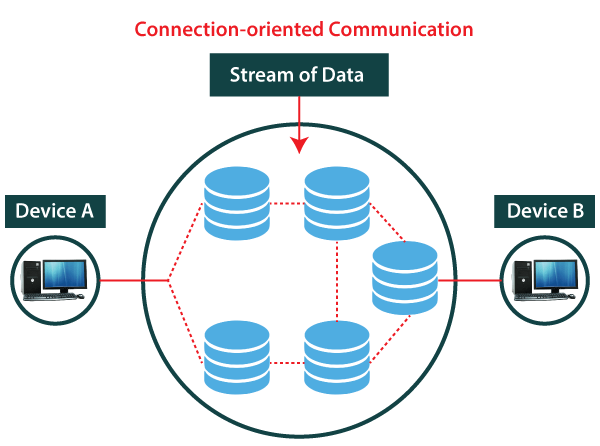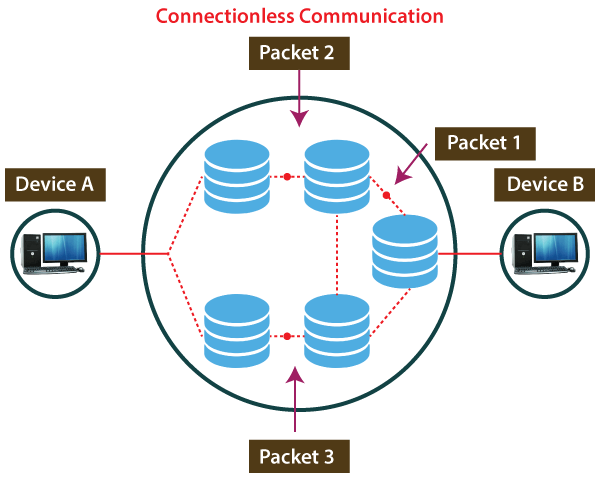Difference between Connection-Oriented and Connectionless Service
Data communication is a telecommunication network to send and receive data between two or more computers over the same or different network. There are two ways to establish a connection before sending data from one device to another, that are Connection-Oriented and Connectionless Service. Connection-oriented service involves the creation and termination of the connection for sending the data between two or more devices. In contrast, connectionless service does not require establishing any connection and termination process for transferring the data over a network.
Connection-Oriented Service
A connection-oriented service is a network service that was designed and developed after the telephone system. A connection-oriented service is used to create an end to end connection between the sender and the receiver before transmitting the data over the same or different networks. In connection-oriented service, packets are transmitted to the receiver in the same order the sender has sent them. It uses a handshake method that creates a connection between the user and sender for transmitting the data over the network. Hence it is also known as a reliable network service.

Suppose, a sender wants to send data to the receiver. Then, first, the sender sends a request packet to a receiver in the form of an SYN packet. After that, the receiver responds to the sender’s request with an (SYN-ACK) signal/packets. That represents the confirmation is received by the receiver to start the communication between the sender and the receiver. Now a sender can send the message or data to the receiver.
Similarly, a receiver can respond or send the data to the sender in the form of packets. After successfully exchanging or transmitting data, a sender can terminate the connection by sending a signal to the receiver. In this way, we can say that it is a reliable network service.
What is a TCP?
TCP (Transmission Control Protocol) is a connection-oriented protocol that allows communication between two or more computer devices by establishing connections in the same or different networks. It is the most important protocol that uses internet protocol to transfer the data from one end to another. Hence, it is sometimes referred to as TCP/IP. It ensures that the connection is established and maintained until the data packet is transferring between the sender and receiver is complete.
Connectionless Service
A connection is similar to a postal system, in which each letter takes along different route paths from the source to the destination address. Connectionless service is used in the network system to transfer data from one end to another end without creating any connection. So it does not require establishing a connection before sending the data from the sender to the receiver. It is not a reliable network service because it does not guarantee the transfer of data packets to the receiver, and data packets can be received in any order to the receiver. Therefore we can say that the data packet does not follow a defined path. In connectionless service, the transmitted data packet is not received by the receiver due to network congestion, and the data may be lost.

For example, a sender can directly send any data to the receiver without establishing any connection because it is a connectionless service. Data sent by the sender will be in the packet or data streams containing the receiver’s address. In connectionless service, the data can be travelled and received in any order. However, it does not guarantee to transfer of the packets to the right destination.
What is UDP?
The UDP (User Datagram Protocol) is a connectionless protocol that allows communication between two or more devices without establishing any connection. In this protocol, a sender sends the data packets to the receiver that holds the destination address. A UDP does not ensure to deliver the data packets to the correct destination, and it does not generate any acknowledgment about the sender’s data. Similarly, it does not acknowledge the receiver about the data. Hence, it is an unreliable protocol.
Connection-Oriented vs Connectionless Service
| S. No | Comparison Parameter | Connection-oriented Service | Connection Less Service |
|---|---|---|---|
| 1. | Related System | It is designed and developed based on the telephone system. | It is service based on the postal system. |
| 2. | Definition | It is used to create an end to end connection between the senders to the receiver before transmitting the data over the same or different network. | It is used to transfer the data packets between senders to the receiver without creating any connection. |
| 3. | Virtual path | It creates a virtual path between the sender and the receiver. | It does not create any virtual connection or path between the sender and the receiver. |
| 4. | Authentication | It requires authentication before transmitting the data packets to the receiver. | It does not require authentication before transferring data packets. |
| 5. | Data Packets Path | All data packets are received in the same order as those sent by the sender. | Not all data packets are received in the same order as those sent by the sender. |
| 6. | Bandwidth Requirement | It requires a higher bandwidth to transfer the data packets. | It requires low bandwidth to transfer the data packets. |
| 7. | Data Reliability | It is a more reliable connection service because it guarantees data packets transfer from one end to the other end with a connection. | It is not a reliable connection service because it does not guarantee the transfer of data packets from one end to another for establishing a connection. |
| 8. | Congestion | There is no congestion as it provides an end-to-end connection between sender and receiver during transmission of data. | There may be congestion due to not providing an end-to-end connection between the source and receiver to transmit of data packets. |
| 9. | Examples | Transmission Control Protocol (TCP) is an example of a connection-oriented service. | User Datagram Protocol (UDP), Internet Protocol (IP), and Internet Control Message Protocol (ICMP) are examples of connectionless service. |
